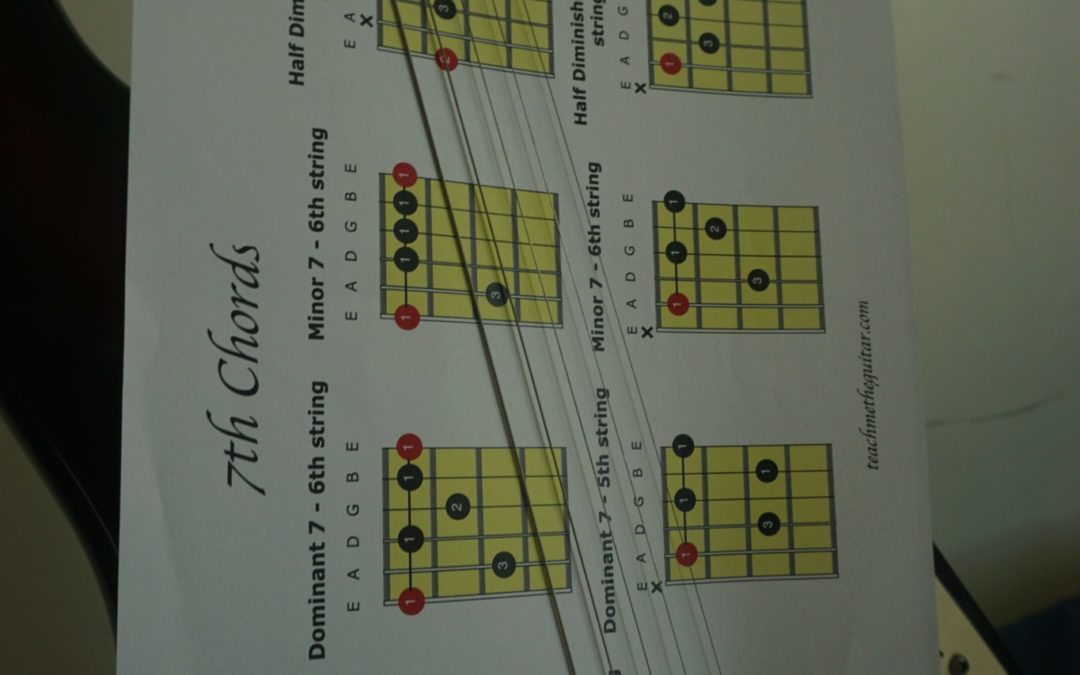Alright, now we're getting into the fun stuff. 7th chords are great for creating more interest in your music and for fooling people into thinking you can play jazz.
In this edition we will be referring back to both part 1 and part 2, so if you haven't checked them out yet, be sure to. Any foundational or assumed knowledge dealt with today will be found there, apart from sections marked 'advanced'.
Today we're going to look at five different types of 7th chords:
Major 7
Dominant 7
Minor 7
Half Diminished 7
Full diminished 7
These are going to be built from the major, minor and diminished triads.
Major 7:
Very simply, this chord is a major triad with an added Major 7th note/interval.
i.e. Root Maj3 Perf5 Maj7
As seen in part 2, the Major 7 interval is 5.5 tones, though an easier one is to just think one semitone down.
i.e. C - B
A - G#
So for example, an E Maj7 will have E, G#, B, D#.
A Major 7 chord will be labeled either as M7 (capital M), Maj7 or Δ7.
i.e. AM7, BbMaj7, DΔ7
Dominant 7:
These are very cheesy sounding chords and in some ways the pinnacle 7th chord.
The Dominant 7th chord is built from a major triad and has a minor 7th note (5 tones or 1 town down) added.
i.e. Root, Maj3, 5th, min7
Therefore, E Dominant 7 would have the notes E, G#, B, D.
A Dominant 7 will usually be labeled as just "7", i.e. E7, but may also be labeled "Dom7", i.e. EDom7
ADVANCED - The reason it is called a dominant 7 has to do with the 5th note in a major scale. The 5th note of the major scale is called the dominant due to being the most relevant or important note apart from the root/tonic. Any chord built upon this note is called a "dominant" chord. Within the major scale, the only time this "dominant 7" chord occurs is when it is built from the 5th/dominant note.
Minor 7:
Going by the pattern, I bet you probably worked this one out - minor triad with a minor 7.
i.e. Root, m3, 5th, m7
E.g. Dm7 = D, F, A, C
The minor 7 chord will be named as either "m7" (small m) or "-7". E.g. C#m7, F-7
Half Diminished (7) Chord
If your first question is "why is this called a 'half' diminished?" I will get to that when I explain the full diminished as it requires a bit of context.
It is usually named with this symbol ø (no need for the 7 to be written) or as m7b5
E.g. Gø
Bbm7b5
As the name suggests, this is built from the diminished triad (found in part 2) and has a minor 7th attached:
i.e. Root, m3, dim5, m7.
E.g. Gø - G, Bb, Db, F
Full Diminished 7 Chord
A full diminished chord can also be built from a diminished triad, however, this time we add a major 6, rather than a minor 7.
The full diminished 7 will be indicated with a small circle o just like the diminished triad, then with a "7" attached.
i.e. Co7
This is quite advanced but the reason why this is called a full diminished 7 is because it is actually built from a diminished scale, rather than a major scale.
ADVANCED - Where a major scale has 7 notes and it's intervals are T T S T T T S, the diminished scale has 8 notes and moves T S T S T S T S.
So while the "7th" of the full diminished 7 is actually a Major 6, it is the 7th note of the diminished scale from which the chord is built.
That is how this chord gets the name full diminished 7, while the other is named half diminished 7.
There you have it, the theory behind 7th chords. To put these into practice I'm very excited to release to you my resources page where there is an evergrowing library of downloadable PDF resources, including a PDF showing you how to play the various 7 shapes (excluding full diminished 7).
Check it out, like, share, subscribe, comment and don't forget to contact me for lessons or even just to say hey.
